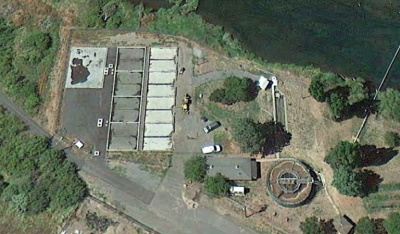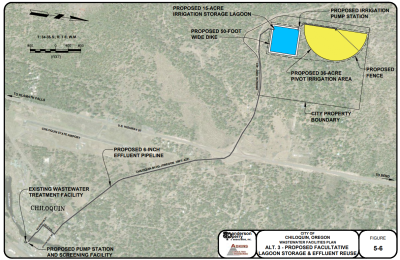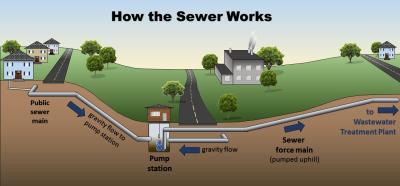
Purpose of Wastewater Project
The current wastewater treatment facility (WWTF) for the City of Chiloquin (City) is located near the center of the City, south of Chocktoot Street, and east of the Williamson River. A majority of Chiloquin’s existing facilities and equipment are approximately 40 years old, indicating that the equipment is nearing or exceeding the end of its design life. The WWTF consists of a contact stabilization package treatment plant that combines an activated sludge process in one unit. The package treatment plant contains first-stage aeration, clarification, second-stage aeration, and an aerobic digester. In addition to the package treatment plant, the WWTF contains sludge drying beds, a chlorine contact basin, and a dechlorination system.
A thorough evaluation was conducted of the City’s WWTF, and a Wastewater Facilities Plan (WWFP) was prepared for the City by Adkins Consulting Engineering, LLP in conjunction with Anderson, Perry and Associates, LLC., which concluded that the system is in need of replacements and major upgrades regardless of whether any growth occurs in the Chiloquin service area.
Several factors indicate an upgrade is needed:
- New Limits – The existing treatment facility was not designed to remove phosphorus.
- Preliminary Treatment – A new headworks screening system is needed.
- Age – Many of the existing facilities were constructed as part of the 1976 wastewater system improvements. This makes the equipment approximately 40 years old and suggests the equipment is nearing the end of its design life and is in need of repair or maintenance.
- Redundancy – The existing facility will not allow the main treatment processes to be taken offline for maintenance. For this reason, the facility needs repair and is underperforming due to the poor condition of air diffusers, etc.
Facility Upgrade Alternatives
The following three treatment process alternatives were developed and evaluated to provide a reliable facility that provides biological treatment and meet the effluent quality requirements:
- Treatment Process Alternative No. 1 – Membrane Bioreactor (MBR) Package Plant
- Treatment Process Alternative No. 2 – Sequencing Batch Reactor (SBR) Package Plant
- Treatment Process Alternative No. 3 – Construct New Lagoon Treatment, Storage, and Effluent Reuse Facility
Each of the alternatives would be designed to meet expected loads through the year 2038 for a projected population of 770 residents. The alternatives had to be operator friendly, energy efficient, and meet Class II reliability criterion, meaning that the facility could operate with the largest single component out of service. The effluent of all alternatives must also be capable of meeting the Oregon's Department of Environmental Quality (DEQ) criteria for secondary treatment.
Of the three viable alternatives that were evaluated, Treatment Process Alternative No. 3 – Construct New Lagoon Treatment, Storage, and Effluent Reuse Facility was selected by the City. This selected improvement option has the lowest Operation, Maintenance, and Repair (OM&R) costs and as a result will be more cost effective for the city even when considering the large upfront costs. The Lagoon Storage and Effluent Reuse Facility will consist of a screening facility, pump station, lagoon facility, irrigation pump, solid set irrigation, and an irrigation field. The selected alternative, Lagoon Storage and Effluent Reuse Facility and associated upgrades, is estimated to cost $3,791,000.
With this alternative, the existing WWTF would be decommissioned and a new or modified pumping system and pipeline to the new non-discharging facultative lagoon system would be constructed to treat effluent and store the reclaimed water for reuse as irrigation. The new WWTF would consist of a new two-cell lagoon system, chlorine disinfection system, and irrigation area. The first cell would be approximately 7 acres and be used for treatment purposes, while the second cell would be approximately 10 acres and be used for storage. The total irrigation area, which will be used to irrigate native vegetation, would be approximately 41 acres.
Today, lagoon/irrigation style WWTFs are widely used across Klamath County and eastern Oregon including Merrill, Malin, Bonanza, Bly, and Crescent.
Project Status
In 2021, Klamath County approved the project, but currently there is an land use appeal underway with the Oregon Land Use Board of Appeals (LUBA). The City is planning to file for a Community Development Block Grant (CDBG) in the spring of 2022. If the City is successful in securing the CDBG grant and with the LUBA appeal process, then construction would start during the summer of 2022.
Project Background
The City of Chiloquin owns and operates a conventional gravity wastewater collection system with lift stations near the wastewater treatment facility (WWTF) and a contact stabilization package treatment plant that provides secondary treatment of the wastewater. Currently, the City’s wastewater system serves a population of approximately 735 residents and commercial establishments. The wastewater collection and treatment system operates under authority of a National Pollutant Discharge Elimination System (NPDES) Permit issued by the Oregon Department of Environmental Quality (DEQ). The Permit was renewed in 2016. The NPDES Permit authorizes the City to construct, modify, and operate the facilities and discharge disinfected secondary treated effluent year-round to the Williamson River.
On July 9, 2003, the City was issued a Notice of Noncompliance (NON), ERB-03-10472, for failing to meet total suspended solids (TSS) removal efficiencies and for exceeding weekly average effluent TSS concentration limits. On April 16, 2004, the City was issued another NON (ERB-2004-11513) for failing to meet TSS removal efficiencies. Also, a warning letter and pre-enforcement letter were written on July 22, 2005, and February 16, 2007, respectively, notifying the City of permit violations regarding TSS removals. To address the compliance matter and provide the City with a scheduled time frame for implementing corrective measures and improvements to the facilities, the City was issued Mutual Agreement and Order (MAO) Number WQ/M-ER_06-245 on February 15, 2007.
Current collection system
The City’s collection system is composed of approximately 30,000 lineal feet (LF) of gravity sewer mains, 1,675 LF of pressure sewer mains, and four lift stations (Eastside, Westside, High School, and Baker Street). A private pump station serves approximately seven lots along the west side of the Williamson River, north of Chocktoot Street and east of Lalo Street. The size of piping in the collection system ranges from 4- to 12-inch diameter, with the majority being 8-inch diameter. The original collection system was installed prior to the 1950s and included the Eastside lift station. In 1961, improvements were made to the wastewater system that included new sewer main lines, and the Westside lift station was constructed to serve the area of the City west of the Williamson River. Major wastewater collection system improvements were carried out in 1975 to reduce infiltration/inflow (I/I). Work included raising and sealing manholes, sealing pipe joints, and replacing portions of the sewer main line. In 1981, the Baker Street lift station was constructed to serve an area north of the WWTF, east of the Williamson River, and west of the Southern Pacific Railroad tracks. In the 2011 Wastewater Facility Improvements - Phase 1 project, an influent flow meter was added, additional sludge drying beds were built, and a dechlorination system was implemented.
New New Lagoon Treatment, Storage, and Effluent Reuse Facility
The proposed Lagoon Storage and Effluent Reuse facility is a system that will have to be monitored and maintained properly to ensure groundwater is protected. The storage lagoons will be lined to eliminate waste-to-soil interactions and protect groundwater. The irrigation will be applied to high water intake crops at agronomic rates to eliminate excessive groundwater seepage. Therefore, the groundwater will not be affected through the use or construction of this system.
Equipment
The Lagoon Storage and Effluent Reuse facilities will include pumps, valves, storage lagoons, a field, and a solid set irrigation. It is also equipped with a screening facility to remove rags, plastics, and other items that are not biodegradable before the effluent is pumped through the pipeline, which is missing in the City’s current WWTF. The existing WWTF will be decommissioned, discontinuing the discharge of effluent into the Williamson River. The existing lift station will be used to pump effluent to the screening facility, after which the effluent is pumped through a 6-inch pipeline to the lagoon storage.
Lagoons
The lagoons will be facultative meaning they consist of 3 distinct layers (aerobic, facultative and anaerobic). The aerobic top layer of the lagoon requires both sunlight and oxygen to function properly. It treats the wastewater by converting it into ammonia, carbon dioxide and phosphates which are absorbed by algae in the lagoons. The bottom layer of the lagoon contains a layer of sludge which is digested by the anaerobic bacteria, helping minimize sludge accumulation in the ponds. The intermediate facultative layer contains both aerobic and anaerobic bacteria. The Lagoon will have a liner to eliminate contamination into the ground water.
Disinfection
After treatment in the storage lagoons the wastewater will travel through a chlorine disinfection pipe to the irrigation pump. This final disinfection will eliminate any viruses and bacteria that may have survived the treatment lagoons.
Irrigation
After chlorine contact the reclaimed water is pumped to a 41-acre area for irrigating native vegetation. Irrigation schedules should be monitored closely to minimize excess irrigation water.


